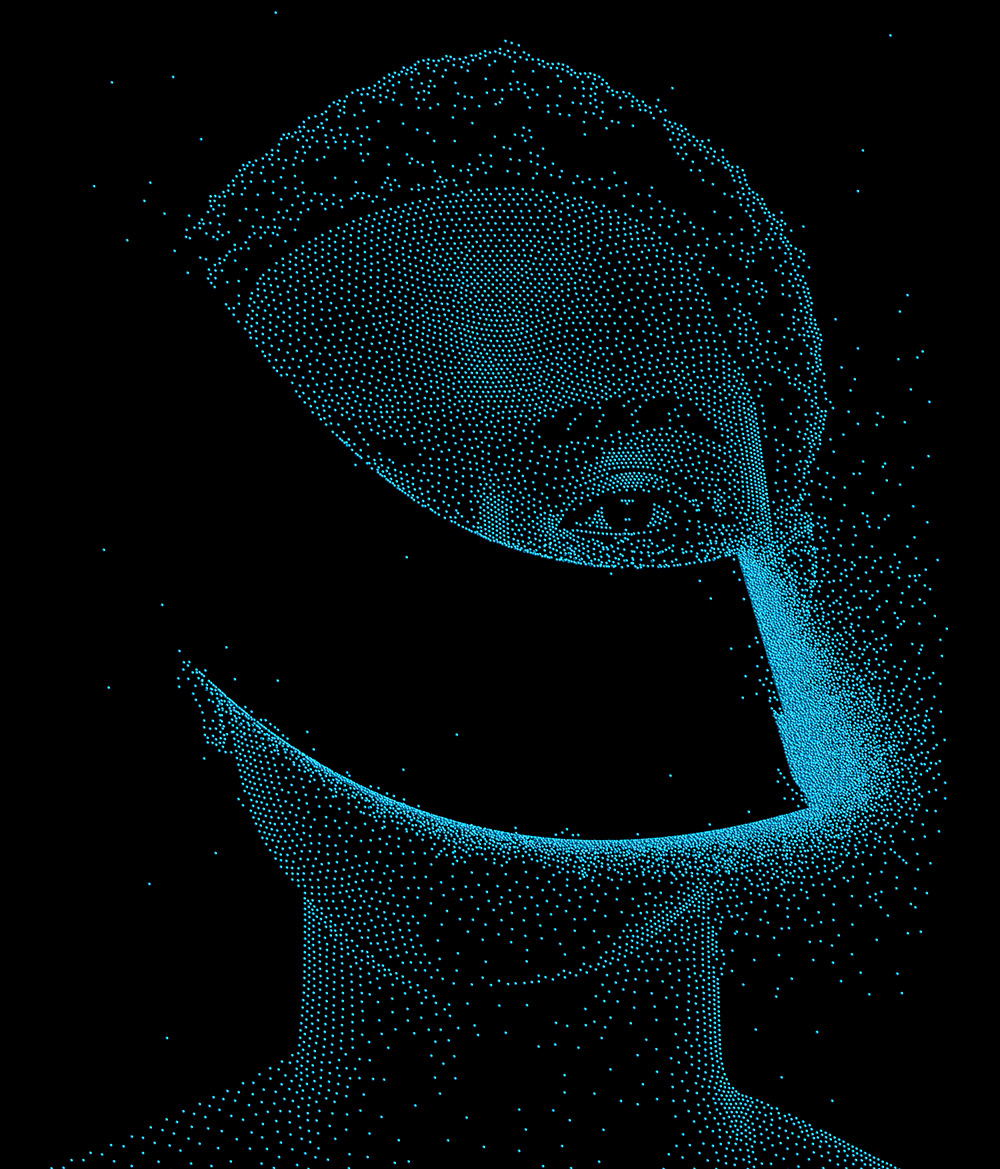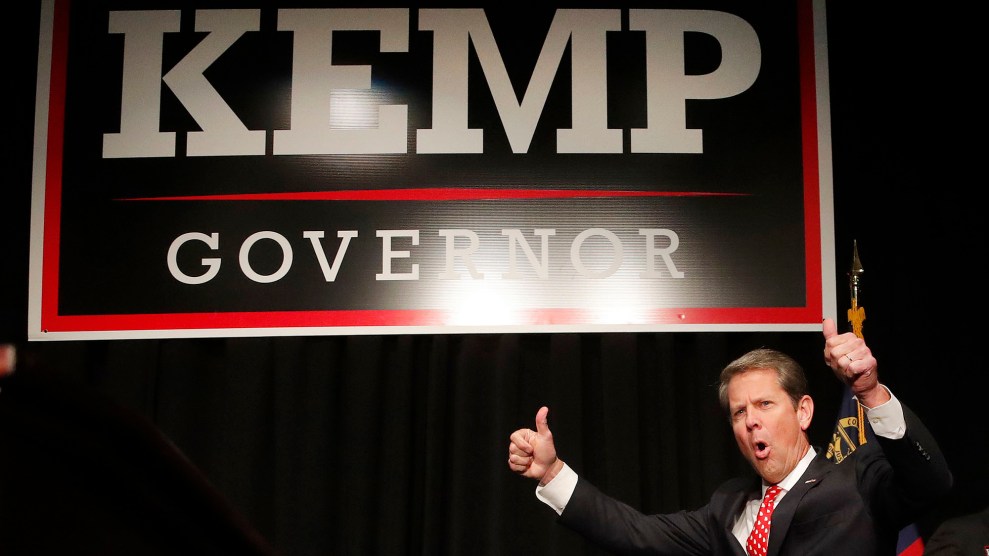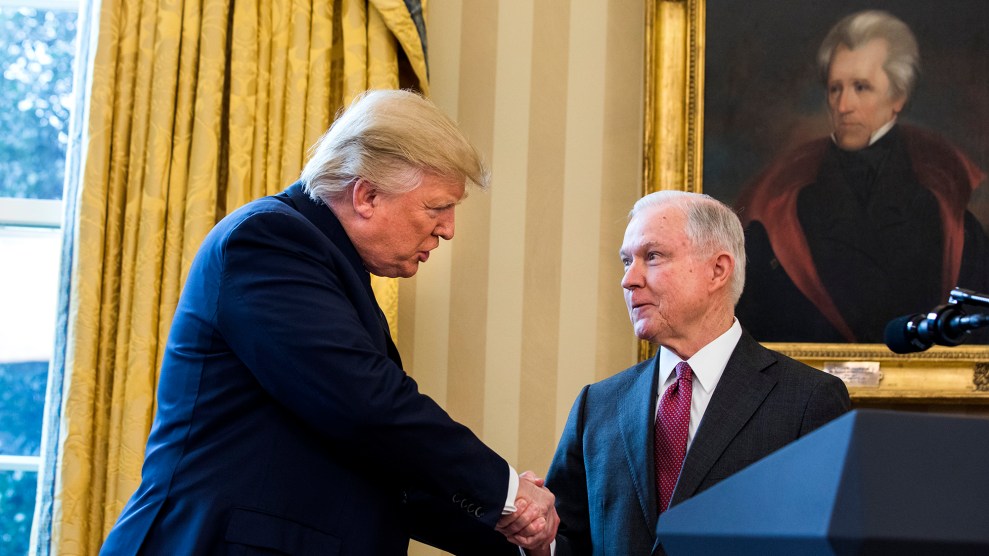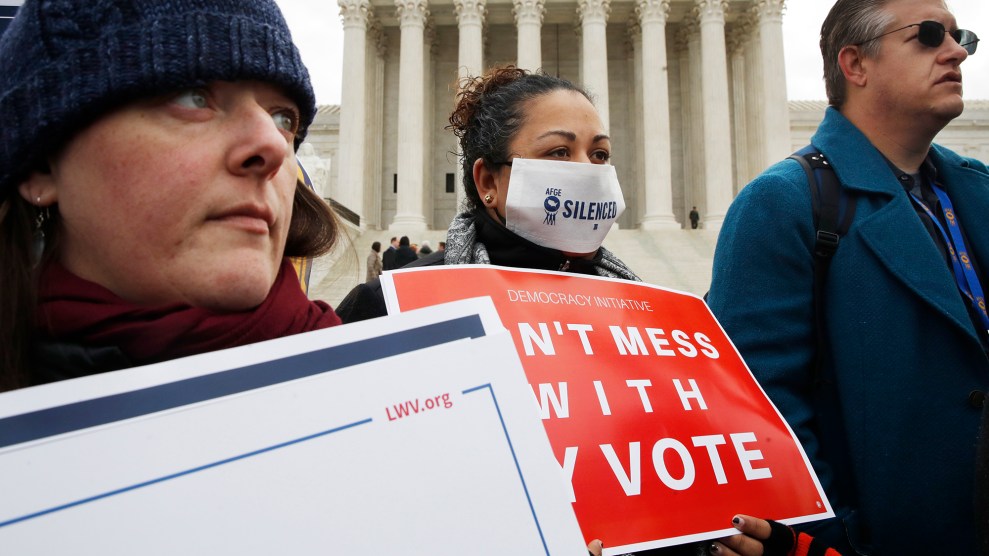In February, Michelle Mackey, a 53-year-old Milwaukee resident, went to cast her ballot in a local primary for mayor and county executive. Mackey describes herself as an “avid voter” who participates regularly in state and national elections, and took part in voter registration drives in 2016. But when she arrived at her polling place at Washington High School, in the city’s Sherman Park neighborhood, which is predominantly Black, she said she was told there was no record of her registration. “I was mad as hell,” she recalled.
She feared she had been purged from the voter rolls—and with good reason. Just before Christmas, she saw on the news that Wisconsin had identified 232,000 voters it claimed had moved and had been ordered to remove them from its registration lists within 30 days if they did not respond to a mailing.
It’s not exactly clear why Mackey was told she was not registered to vote. Just in case, she’d come with her ID and electric bill. She was able to cast a ballot that day, and records show she was still in the poll book. But the whole experience left her upset. The state’s effort to remove voters, Mackey said, was “a slap in the face to minorities and people of color.”
In Milwaukee, which is home to nearly two-thirds of the state’s Black population, one in eight registered voters was at risk of being purged. African American turnout in the city had already plummeted in 2016 after Republicans passed a voter ID law that, according to a Republican Senate aide’s sworn testimony, was aimed squarely at Milwaukee and other Democratic-leaning cities.
Fifty-five percent of the registration notices were sent to municipalities where Hillary Clinton had defeated Donald Trump, according to the Milwaukee Journal Sentinel, and nine of the 10 areas with the highest concentration of voters on the purge list were big cities and college towns that had voted for Clinton. Milwaukee and Madison, the state’s two Democratic strongholds, accounted for 14 percent of the state’s registered voters but 23 percent of the names on the removal list. Voters in predominantly Black neighborhoods or areas with large student populations were nearly twice as likely to be flagged for removal, The Guardian found.
The state’s bipartisan elections commission had originally planned to give voters until 2021 to confirm their addresses and registration status before removing them from the rolls. But in November 2019, the Wisconsin Institute for Law and Liberty, a conservative group, sued the commission to force it to immediately purge voters who had not responded to the mailing. A month later, a Republican-appointed judge, Paul Malloy, sided with the group and approved the fast-tracked purge.
That meant 7 percent of the state’s electorate could be removed from the voter rolls ahead of what’s expected to be a close presidential race in a state Trump won by only 22,000 votes in 2016. Nearly three-quarters of the people on the purge list voted in 2016, suggesting they’re likely to want to vote in 2020. In late February, a state appeals court blocked the purge, ruling that local election clerks, not the elections commission, are responsible for maintaining the state’s voter rolls. But the state Supreme Court could still revive the purge before the November election.
Wisconsin’s disastrous election on April 7 showed the extreme lengths Republicans would go to in order to keep their conservative majority on the state Supreme Court. Despite the raging coronavirus outbreak, Republican legislative leaders rebuffed Democratic Gov. Tony Evers’ calls to delay the election or mail a ballot to every registered voter. While a liberal candidate unseated a conservative justice, the court’s majority still leans right.
Wisconsin is not the only state taking aggressive action to trim voter rolls. Days after Malloy’s ruling, Georgia’s Republican secretary of state, Brad Raffensperger, purged more than 300,000 voters—4 percent of the electorate—whose registrations were deemed inactive or out of date, including 120,000 who were removed because they hadn’t voted in several previous elections and hadn’t responded to a mailing. More than 20,000 who had been wrongly labeled inactive were added back to the rolls following a court filing from Fair Fight Action, a voting rights group founded by 2018 Democratic gubernatorial candidate Stacey Abrams.
Like Wisconsin, Georgia has seen rampant voter suppression and razor-thin elections. Abrams failed to qualify for a runoff against Republican Brian Kemp in the 2018 governor’s race by fewer than 18,000 votes, after Kemp—who as secretary of state oversaw his own gubernatorial election—instituted a number of practices that made it harder to vote. That included putting 53,000 voter registrations on hold before the election—80 percent of them from voters of color—and advising counties on how to close polling places. More than 200 precincts closed, primarily in areas with large Black populations.
The purges in Wisconsin and Georgia—and other states, like Ohio, which released a purge list with tens of thousands of errors last year—are part of a decade-long push, by Republican officials and conservative legal groups, that has removed Democratic constituencies and people of color from registration lists. From 2016 to 2018, 17 million Americans—8 percent of the nation’s electorate—were taken off the voting rolls, according to the Brennan Center for Justice. Many of these removals took place in states with a long history of voting discrimination. The coronavirus outbreak could amplify the impact of these purges by making it even harder for people who have been delisted to reregister.
“Especially in states like Georgia, where diversifying demographics have us on the precipice of transformative political change, we are seeing Republicans employ voter suppression to limit who has access to the polls,” says Abrams. “Disproportionately, under GOP secretaries of state, this process affects Democrats, particularly in communities of color.” She adds, “The clear intention is to strip people of their right to vote.”
It’s long been said that elections are decided by turnout, but in 2020 we have to ask a different question: Will tens of thousands of voters in critical battleground states find out they’re unable to cast a ballot?
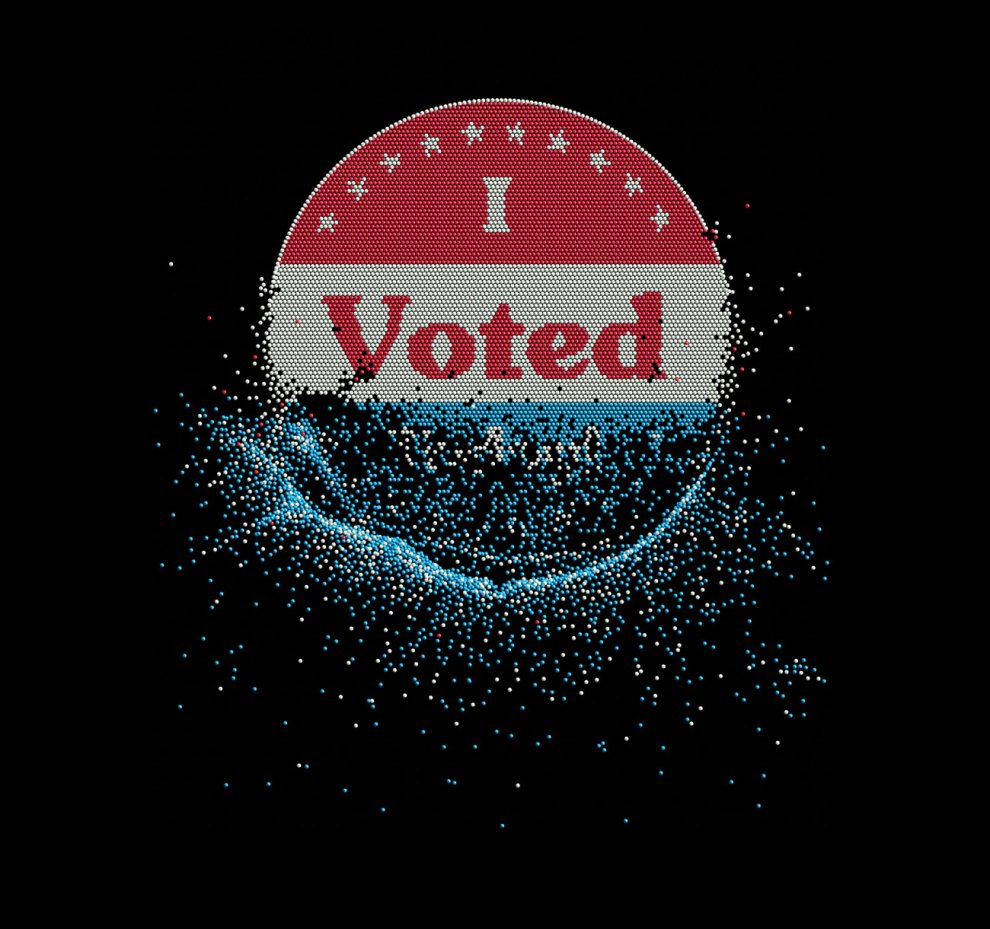
At the country’s founding, there was no voter registration in the United States. People simply showed up at the polls, offering credentials such as proof of property or residency as needed, and counting on officials or neighbors to recognize and vouch for them. Early registration laws, passed in the mid-1800s, when the vote was still mostly limited to white men, were largely designed to prevent rather than encourage political participation. As historian Alexander Keyssar writes in The Right to Vote, in 1840 the Whig Party in New York passed a voter registration law that applied only to New York City, clearly aimed at Irish Catholic immigrants, who voted Democratic.
Voter registration laws became a widespread tool of voter suppression in the tumultuous era after Reconstruction, as Southern states sought to disenfranchise African Americans, and Northern states sought to disenfranchise immigrants. During the Jim Crow era, literacy tests and poll taxes made it all but impossible for the majority of Black Americans to register to vote, and frequent voter purges kept many who did register from holding onto the right.
Following the Brown v. Board of Education decision in 1954, the Louisiana legislature formed a Segregation Committee, which advocated widespread voter purges as a way to keep Black Americans from organizing politically. State Sen. Willie Rainach authored a pamphlet called “Voter Qualification Laws in Louisiana: The Key to Victory in the Segregation Struggle.” In 1959, the White Citizens Council of Washington Parish, north of New Orleans, convinced local registrars to remove 85 percent of Black registered voters for alleged defects in their registration cards, but just 0.07 percent of white voters. A federal court reversed the purge, calling it a “massively discriminatory” scheme to “remove almost all of the Negro voters from the rolls and leave the white voters practically untouched.”
The Voting Rights Act of 1965 outlawed many of these suppressive laws and tactics, and the National Voter Registration Act of 1993, known as the “motor voter” law, made voter registration far more accessible by allowing people to register at DMVs and other public agencies.
Yet purges persisted as Republicans sought new ways to circumvent protections for voters of color, a growing part of the electorate that favored Democratic candidates. During a 1981 gubernatorial election in New Jersey, the Republican National Committee used outdated registration lists to send sample ballots to largely nonwhite neighborhoods. When 45,000 mailers were returned as undeliverable, the RNC created a list of voters to challenge at the polls, stationing armed off-duty cops wearing “National Ballot Security Task Force” armbands at heavily Black and Latino polling sites in Newark and Trenton. The Democratic candidate, Jim Florio, lost the race to Republican Tom Kean by 1,797 votes. The RNC chair credited the tactic for Kean’s victory. The Democratic National Committee won a legal settlement restricting the RNC’s future “ballot security” operations, which functioned as unofficial voter purges.
Five years later, during a US Senate race in Louisiana, the RNC sent similar mailers to majority-Black precincts and used the returned mail to generate a list of 31,000 mostly Black voters to challenge at the polls. A committee official said the effort would “keep the Black vote down considerably.” (The settlement expired in 2017, potentially opening the door to new voter challenges by Republicans in 2020.)
In 2000, a purge changed the outcome of a presidential election and the course of American history. Under Republican Gov. Jeb Bush and Secretary of State Katherine Harris, Florida sent election supervisors a list of 58,000 people the state believed had felony records. (At the time, Florida was one of a handful of states that permanently prevented people with past felony convictions from voting.) But Florida did not stop at purging people convicted of felonies. People were added to the purge list if 70 percent of the letters in their names matched an entry in the state’s felony database. The list was both discriminatory—African Americans made up 11 percent of registered voters in the state but 44 percent of the purge list—and wildly inaccurate. After the election—and following the Supreme Court’s 5–4 decision stopping the state’s recount—an official audit found that as many as 12,000 registered voters had been mislabeled as having felony records, a number 22 times greater than George W. Bush’s 537-vote margin of victory.
Instead of backing away from voter purging, the Justice Department under Bush accelerated its use, suing four states for violating a provision of the 1993 motor voter law that required states to make “a reasonable effort to remove” voters who had died or moved from the official lists. (The clause had been inserted into the bill to win GOP support.) The Bush administration interpreted the provision far more aggressively than the Clinton administration had, turning a law that was supposed to help people register to vote into a weapon to remove voters from the rolls.
Missouri was one of the states the administration sued. Like Florida, Missouri was the site of a disastrous purge in 2000. In the runup to the election, the St. Louis election commission sent postcards to all registered voters in the city and reclassified 50,000 voters as inactive after their mail was returned as undeliverable, without notifying them of the change. That led to chaos on Election Day, when thousands of voters found they were on the inactive list.
Under a legal settlement with the Justice Department, St. Louis agreed to refrain from removing voters from the rolls until after the 2004 election, and to notify any voter moved to inactive status. But in 2005, over the objections of the Republican-appointed US attorney for Western Missouri, the Justice Department sued the state to force it to conduct a purge before the 2006 midterm elections. A federal court ruled against the Justice Department, but the Bush administration had already laid the groundwork for using the motor voter law to conduct sweeping voter purges.
After Barack Obama took office, former Bush administration lawyers joined a constellation of conservative legal groups with innocuous-sounding names, such as Judicial Watch, the Public Interest Legal Foundation, and the American Constitutional Rights Union. These groups have sent threatening letters and filed dozens of lawsuits to try to force states and counties with substantial populations of color to purge their voting rolls. “These groups are bullying and pressuring election administrators into purging,” says Myrna Pérez, director of the Brennan Center’s voting rights program.
In January, Judicial Watch sent letters to 19 large counties in California, Colorado, North Carolina, Pennsylvania, and Virginia—all of which voted for Clinton in 2016—warning that they would be sued unless they trimmed their voting rolls within 90 days. Pittsburgh’s Allegheny County, where Clinton won by 17 points, immediately began removing 69,000 inactive voters. Last year, Judicial Watch reached a settlement with California to reassess 1.5 million names on the voter rolls in Los Angeles County. To justify such purges, Judicial Watch has claimed there are more registered voters than adult citizens in some of these places, opening the door to widespread voter fraud.
It repeated this charge right before the 2020 Iowa caucuses, alleging that “eight Iowa counties have more voter registrations than citizens old enough to register.” In fact, only one of these counties had more registered voters than adult citizens, and voting rights experts say there’s little risk of fraud or evidence that people are exploiting out-of-date registrations to impersonate voters who have moved or died. Even Iowa’s Republican secretary of state called Judicial Watch’s assertions “fake news.” (Echoing Judicial Watch’s unsubstantiated claims of bloated voter rolls, another conservative group, the Honest Elections Project, recently threatened to sue Colorado, Michigan, and Florida.)
“The rationale of removing voters from the rolls to protect against fraud is nonsensical,” Abrams says. “This is a pretext for blocking voices they do not want to hear.”
The Trump administration has encouraged such tactics. In June 2017, the Justice Department sent a letter to 44 states informing them that it was reviewing their voter list maintenance procedures and asking how they planned to “remove the names of ineligible voters.” Vanita Gupta, who headed the Justice Department’s Civil Rights Division under President Obama and is now president of the Leadership Conference on Civil and Human Rights, called a mass mailing of this sort “virtually unprecedented.”
The Supreme Court’s conservative majority has abetted these purges every step of the way. In 2013, the court ruled in Shelby County v. Holder that states with a long history of voting discrimination no longer needed to get federal approval for changes to their election laws and voting procedures under the Voting Rights Act. Following that decision, states and counties that were now free to modify their election laws purged voters at a rate 40 percent higher than elsewhere in the country, according to the Brennan Center. Georgia, for example, purged twice as many voters from 2012 to 2016—a total of 1.5 million people—as it did from 2008 to 2012.
Five years after the Shelby decision, the Roberts court voted 5–4 to uphold an Ohio law allowing the state to purge people who had not voted in any election over the previous six years. Voting rights groups argued that the court was turning the right to vote into a “use it or lose it” privilege.
One day after that decision, Trump’s Justice Department joined a lawsuit filed by Judicial Watch that succeeded in forcing Kentucky to begin the process of purging voters labeled ineligible. The effort to purge inactive voters “makes voting the only constitutional right an American can lose if they do not express it,” Abrams says. “I don’t lose my Second Amendment rights because I don’t shoot a gun.”
There’s nothing inherently wrong with updating registration lists to remove the names of people who have become ineligible to vote. “We want election administrators to have the tools they need to make sure that the records are clean,” says the Brennan Center’s Pérez. But recent examples show that some purges mislabel thousands of eligible voters, disproportionately Democrats and people of color.
Last year, Ohio’s Republican secretary of state released a list of 235,000 voters set to be purged because they had died or moved or had not voted over a six-year period. Voting rights groups found 40,000 names that were listed erroneously, including the head of the Ohio League of Women Voters, who had voted in three elections in the previous year but was labeled an inactive voter because of faulty government data. Ohio doesn’t have partisan voter registration, but people who voted in Democratic primaries outnumbered Republican voters nearly two to one on the list.
A similar situation played out in Wisconsin. In 2017, the state sought to remove 340,000 voters who it said had moved, based on data from government agencies. But 7 percent of the people on the list had not moved, according to a detailed analysis of voter registration data by the League of Women Voters of Wisconsin. The city of Milwaukee removed 44,000 voters but later reinstated nearly half of them.
All of this raises questions about the accuracy of the latest purge effort in Wisconsin. The League of Women Voters, which has challenged the purge in state and federal courts, argued in a brief that the list “likely once again contains a substantial amount of unreliable and demonstrably inaccurate information.”
Wisconsin has Election Day registration, so people with registration problems can reregister at the polls. But they’ll need to provide proof of residency, which is not typically required to vote, and voting rights advocates worry that people turned away for lack of proper documentation might not come back. “People get so frustrated that they don’t even want to go through the process,” says the Rev. Greg Lewis of Souls to the Polls Milwaukee, which focuses on Black voter engagement. “That’s the major concern for us.” The spread of the coronavirus could also make it unlikely that people will use Election Day registration, and they might be unable to fix their registration problems through mail-in balloting.
Like Georgia, Wisconsin has already been hit hard by voter suppression. A University of Wisconsin study found that the state’s strict voter ID law blocked or deterred as many as 23,000 residents of Milwaukee County and Madison’s Dane County from voting in 2016—a number larger than Trump’s margin of victory in the state. Black voters were three times as likely as white voters to cite the ID law as a reason they did not cast a ballot.
Neil Albrecht, executive director of Milwaukee’s election commission, fears that the purge could have a similar effect this year. “This will further the mistrust of election administration in Wisconsin,” he says. “That can affect voter participation. If people feel like the system is rigged, and more and more people in Milwaukee are starting to feel that way, it has a pretty profound impact on whether or not they feel it is even worthwhile to participate in an election.”
After Judge Malloy ordered the purge in December, the Wisconsin Elections Commission voted on whether to remove names from the rolls while the case was being appealed. The commission, which consists of three Democrats and three Republicans, split along party lines, and the vote to remove the names failed. A month later, Malloy angrily instructed the commission to begin removing voters immediately and took the unprecedented step of holding the commission and its three Democratic appointees in contempt of court, fining each commissioner $250 a day until they started the purge. It was Malloy’s orders that the appeals court blocked and that the state Supreme Court could reinstate.
Mackey, a third grade teacher’s assistant and the vice president of a branch of her local teachers union, lives in a majority-Black neighborhood on the north side of Milwaukee where voter turnout decreased by more than 20 percent from 2012 to 2016. She had been canvassing the area before the spread of coronavirus and urging people at risk of being purged to confirm their registrations so they don’t get any unpleasant surprises like she did. “A lot of people are planning to reregister due to the situation on 1600 Pennsylvania Avenue,” she told me.
When I asked Mackey why voting was so important to her, she said that her grandfather had grown up in segregated Mississippi, fought in World War II as a Tuskegee Airman, and marched in Selma for the Voting Rights Act. “My ancestors fought for this right,” she said. “They fought in wars for our freedom, for the right to vote. This is our God-given right, and it should not be taken away from us.”
